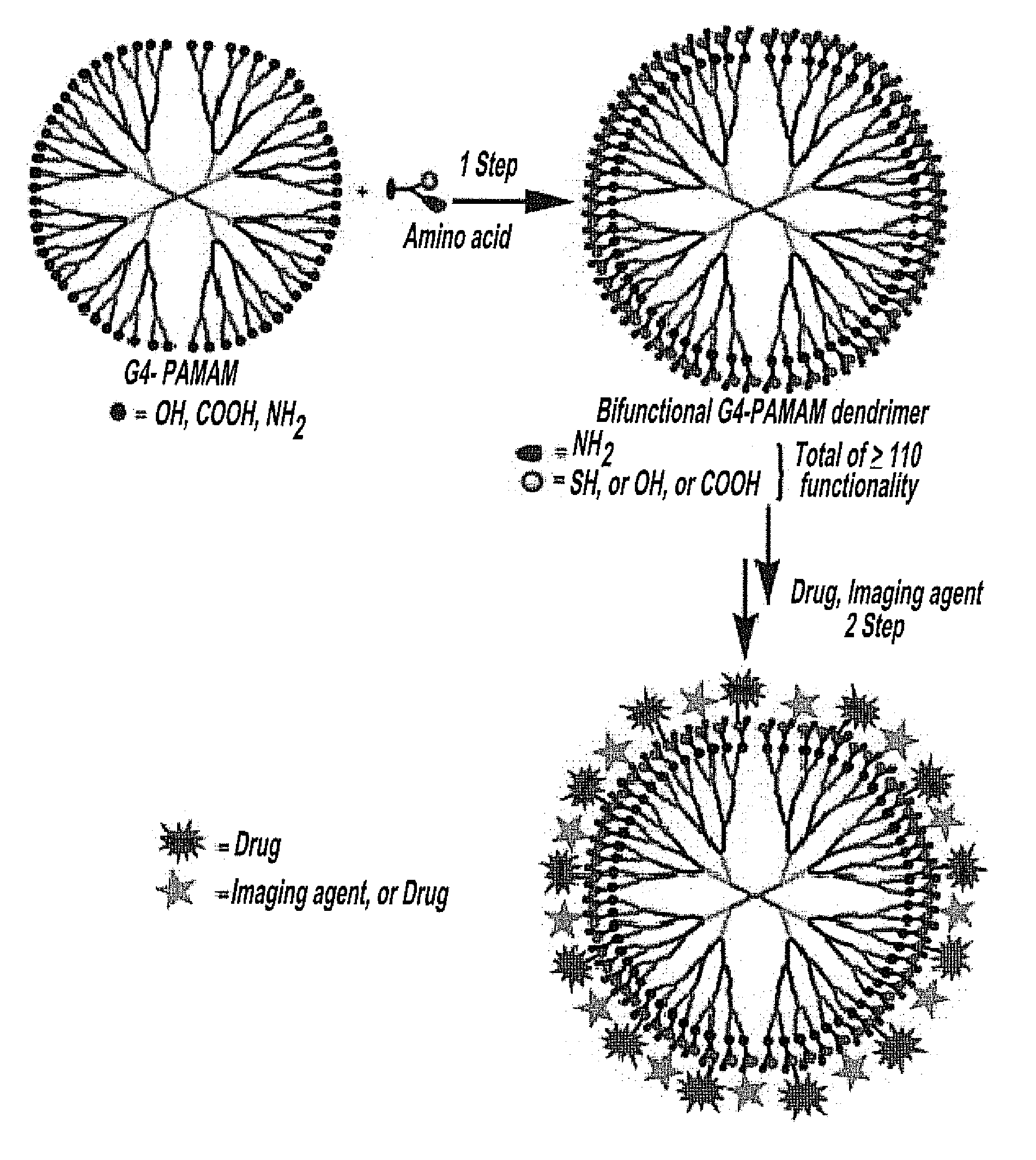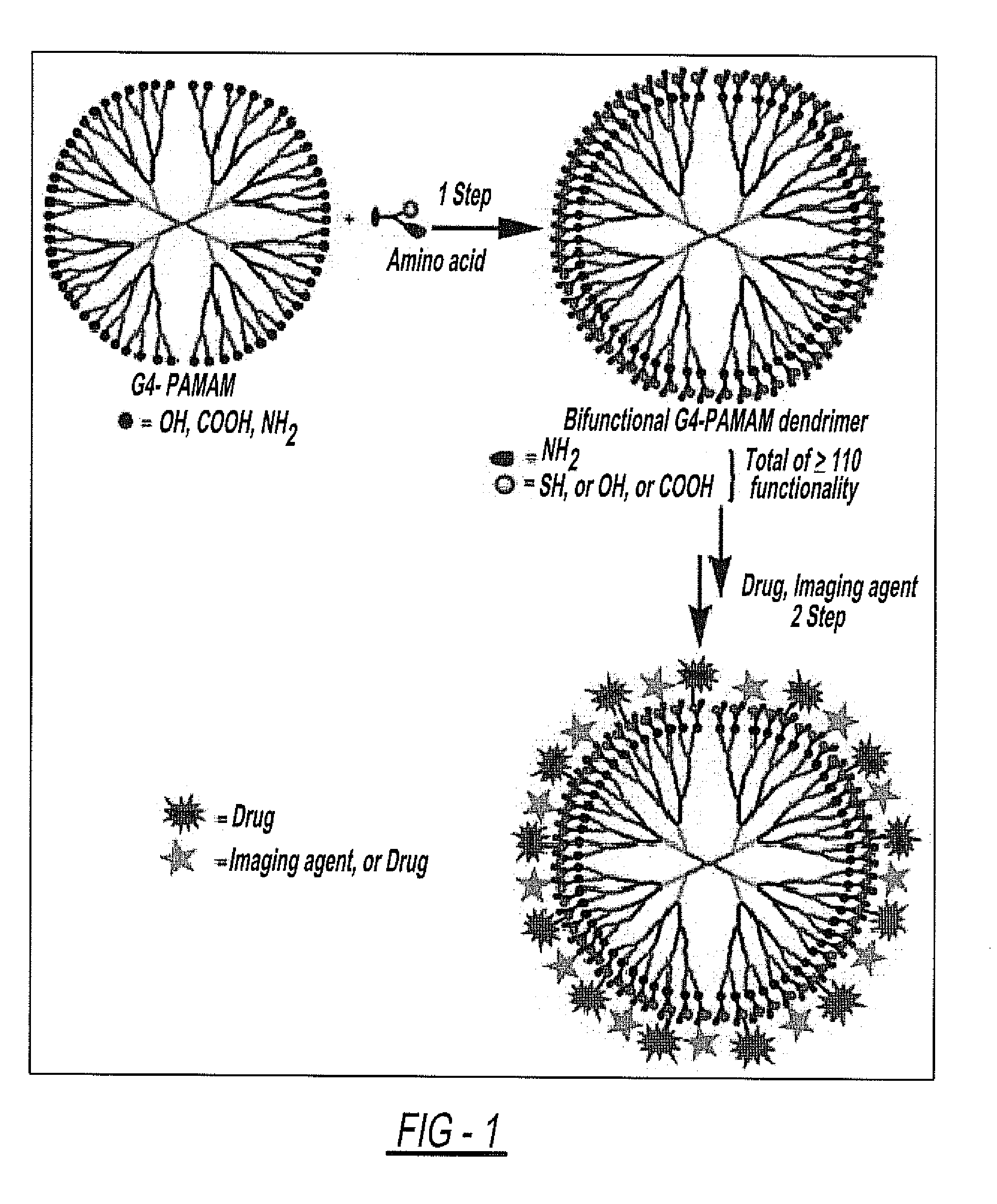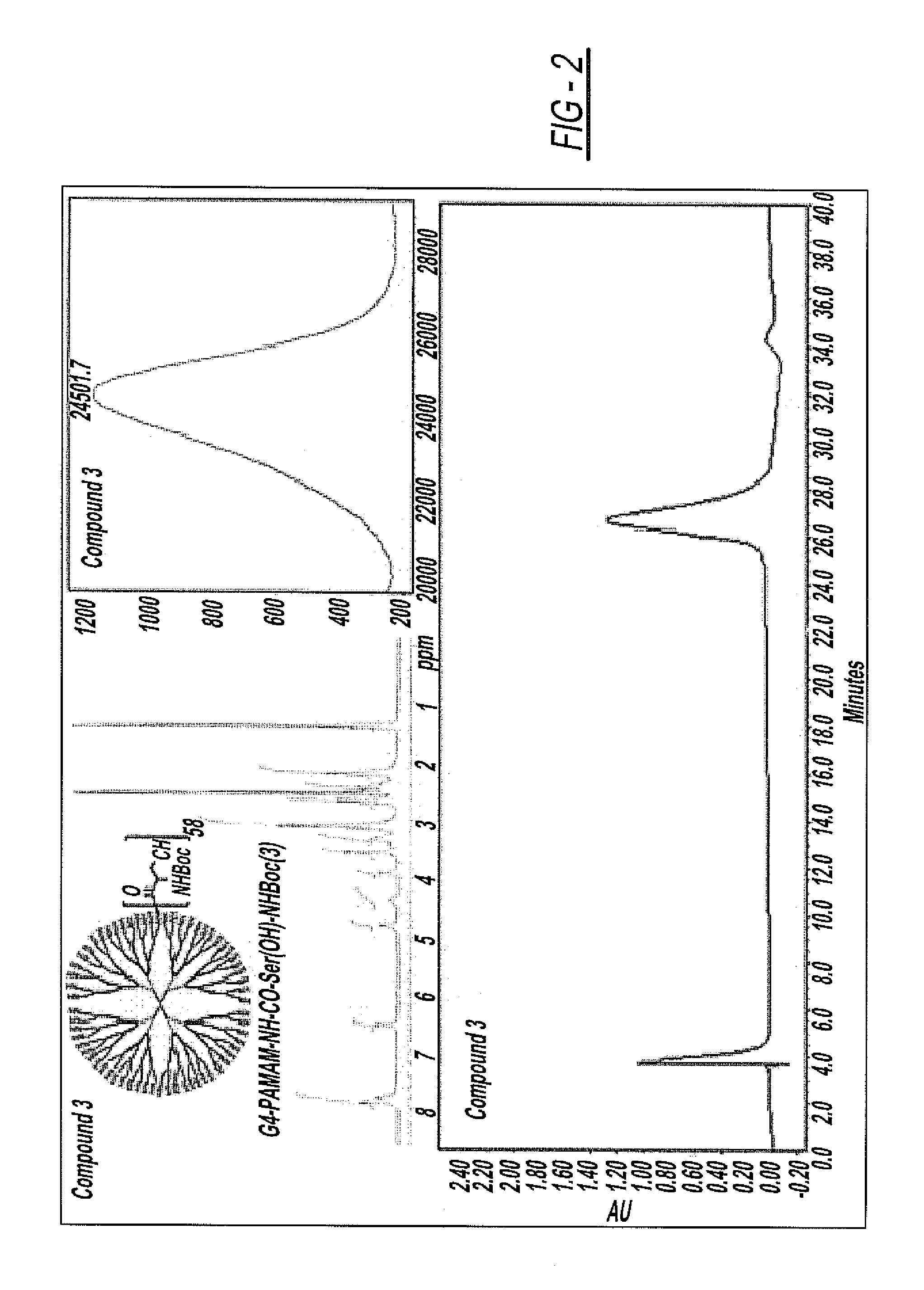Injectable dendrimer hydrogel nanoparticles
a dendrimer and nanoparticle technology, applied in the field of therapeutic agents, can solve the problems of cytotoxicity of cationic dendrimers, affecting the efficiency of gene slicing, and affecting the ability to bind diverse functional moieties (drugs or imaging agents),
- Summary
- Abstract
- Description
- Claims
- Application Information
AI Technical Summary
Benefits of technology
Problems solved by technology
Method used
Image
Examples
example 1
Synthesis of Asymmetrical Hetero-Bifunctional G4 PAMAM Dendrimers
Synthesis of G4-PAMAM-NH—CO-Ser(OH)—NHBoc (3)
[0058]To a stirred solution of G4-PAMAM-NH2 (1) (500 mg, 0.035 mol) and Boc-Ser-NHS (2) (1360 mg, 4.50 mol) in DMSO / DMF (4:1, 25 mL) followed by addition of DIEA (775 μl, 4.50 mol). The reaction was allowed to continue for 24 hours at room temperature (r.t.). The crude product was purified by dialysis against DMSO (3 times for 36 hours), and after dialysis the solvent was removed under lyophilization to get pure compound in 75% yield (646 mg, 0.026 mol). The chemical structure of G4-PAMAM-NH—CO-Ser(OH)—NH2 (3) was confirmed by 1H-NMR and MALDI-MS spectra. 1H-NMR (DMSO-d6, 400 MHz), 1.38 (s, 9H, Boc), 2.10-2.22 (br.s, OH), 3.22-3.38 (m, 1H, CH2), 4.50-4.58 (m, 1H, CH2) 4.80-4.90 (m, 1H, CH) 6.50-6.60 (m, 1H, NH amide), 7.78-7.97 (br.d, NH amide interior dendrimer amide), MALDI-MS: 24501 Da
Synthesis of G4-PAMAM-NH—CO-Ser(OH)—NH2 (4)
[0059]Boc (tert-Butoxycarbonyl) deprotection ...
example 2
Preparation of Dendrimer-PEG-Nanogel
[0098]Nanogel composed of the dendrimer-PDP (or dendrimer drug conjugate) and the PEG-SH (8 arm or liner) were synthesized. In brief, To a solution of 8-arm-PEG-SH (polymer) (100 mg) in PBS(1 ml) (pH=7.4) in 1st 50 ml round bottom flask. Dendrimer-PDP (100 mg) in PBS (1 ml) (pH=7.4) in 2nd 50 ml of round bottom flak. In 3rd round bottom flask containing water phase (50 ml) consisted of a 2.5% (w / v) aqueous solution of the surfactant polyvinyl alcohol (PVA, MW 13,000-23,000, 87-89% hydrolyzed). The above 1st polymer and 2nd dendrimer-PDP was slowly added to the water phase with high-speed blending (24,000 rpm) for two minutes and the mixture formed a cloudy white emulsion. The emulsion was then allowed to stir in an uncovered beaker for several hours (24 hours) in a vacuum hood. The emulsion was centrifuged at 10,000 rpm for 30 minutes. The supernatant was lyophilized and stored for analysis of dendrimer-drug conjugate concentration to be determine...
example 3
Particle Size and Zeta Potential
[0099]The impact of surface modification of the dendrimers on particle size, zeta potential, blood retention and in vivo organ distribution has been previously reported. The complete surface modification of the dendrimers with amino acids on an average increased the particle size by 1-2 nm as seen from Table 3 (Particle size and zeta potential hetero-bifunctional dendrimers). The end capping of the cationic G4-PAMAM-NH2 dendrimer with serine and cysteine resulted in drastic reduction in the zeta potential from +11.5 to −1.83 and 4.80 mV respectively. The interesting part is that both these constructs retain equal number of surface NH2 termini as compared to unmodified G4-PAMAM-NH2, yet exhibit reduced charge and are therefore expected to reduce the cytotoxicity. The hydroxyl terminated G4-PAMAM dendrimers are nontoxic due to the neutral surface charge and end capping it with aspartic acid and cysteine did not increase the charge significantly (Table 3...
PUM
| Property | Measurement | Unit |
|---|---|---|
| molecular weight | aaaaa | aaaaa |
| mass | aaaaa | aaaaa |
| mass | aaaaa | aaaaa |
Abstract
Description
Claims
Application Information
 Login to View More
Login to View More - R&D
- Intellectual Property
- Life Sciences
- Materials
- Tech Scout
- Unparalleled Data Quality
- Higher Quality Content
- 60% Fewer Hallucinations
Browse by: Latest US Patents, China's latest patents, Technical Efficacy Thesaurus, Application Domain, Technology Topic, Popular Technical Reports.
© 2025 PatSnap. All rights reserved.Legal|Privacy policy|Modern Slavery Act Transparency Statement|Sitemap|About US| Contact US: help@patsnap.com



